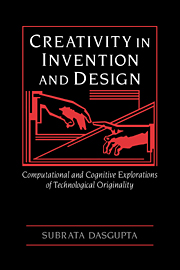Book contents
- Frontmatter
- Contents
- Preface
- Acknowledgments
- Part I Creativity in invention and design: issues and ingredients
- Part II The invention of microprogramming: a cognitive explanation
- Part III Reflections on the nature of inventing
- 7 Eight hypotheses about the nature of inventing
- 8 Epilogue
- Appendix
- References
- Index
8 - Epilogue
Published online by Cambridge University Press: 23 December 2009
- Frontmatter
- Contents
- Preface
- Acknowledgments
- Part I Creativity in invention and design: issues and ingredients
- Part II The invention of microprogramming: a cognitive explanation
- Part III Reflections on the nature of inventing
- 7 Eight hypotheses about the nature of inventing
- 8 Epilogue
- Appendix
- References
- Index
Summary
This brings us to the end of this particular inquiry. We began with a central concern: the nature of creativity as it is manifested in the development or design of artifacts. Not all acts of design count as creative acts. Like ideas and theories about nature or works of literature and art, the creation of artifacts is deemed creative when the outcome is original in some sense. Drawing on a distinction made by Johnson-Laird (1988a), Boden (1991), and others, we saw that it is possible to establish criteria of originality either from the perspective of the individual agent or from that of the society or community to which the agent belongs. When the outcome of an act of design is an artifactual form that satisfies one or more of the criteria of originality, the design act is called inventive or creative design. More simply, we call it invention. Inventing artifactual forms corresponds to discovering laws or inventing theories about natural phenomena. Thus, it seemed reasonable to suppose that studies of creativity in the natural sciences might provide insight into the nature of creativity in the sciences of the artificial.
We saw that philosophy of science, having been primarily preoccupied with the logic of justification, had little to contribute to our inquiry. Fortunately, there has emerged in relatively recent times a new kind of inquiry into scientific activity that draws on the ideas of cognitive psychology, history of science, and artificial intelligence; it was to these sources we turned.
- Type
- Chapter
- Information
- Creativity in Invention and Design , pp. 213 - 216Publisher: Cambridge University PressPrint publication year: 1994



